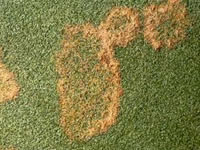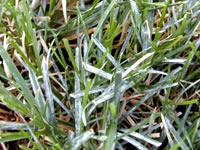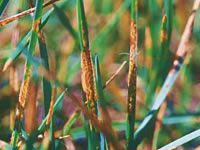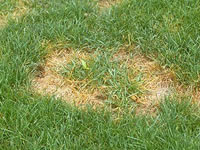Sometimes bad things happen even to the healthiest lawns. Just when we get the lawn looking perfect, along comes a rainy, hot and humid summer....and, with it, sometimes a fungus. Out of all plant diseases, lawn diseases are some of the most difficult to identify and control.
Before you head out to your local nursery and garden center or hardware store to buy a fungicide, read this article to find some helpful information, pictures and prevention and control tips to help you with your lawn problem. The more you know about lawn diseases the better able you are to choose the right method of control.
Many lawn diseases are difficult to distinguish from other common problems, such as insect pests or damage caused by animal urine or feces. If you've been gardening for a number of years, chances are you've already encountered a lawn disease problem. If so, you know the most common method of control is application of a fungicide. But treating everything with a fungicide is not always necessary or the best remedy.
Some lawn diseases simply do not respond to or require a fungicides. Instead, they respond to improved cultural, maintenance and watering practices. Worst case scenario, you might need to consider growing a different type of grass because the one you have is susceptible to fungus in the environment you are trying grow it in. Lawn grasses that prefer full, all-day direct sunlight, such as Bermuda grass, will be more susceptible to fungus in shady or even partially shaded environments. A lawn grass that likes well-drained, sandy soils is more susceptible to disease in poorly draining soils. That being said, no desirable lawn grass I know of likes constantly wet and soggy soil!
Because many lawn diseases are fast spreaders, and can be tracked from one small section of the yard to the entire yard by way or foot traffic or lawn mower tires, the sooner you identify the disease and get it under control the better.
Identifying the disease...
Before trying to cure a disease, first identify the disease. Except for the experienced or trained professional, this is often easier said then done. While some lawn diseases are easy to identify through basic observation, others are very similar in appearance. Even though two different diseases might look alike there can be two different remedies for control.
Ideally, if you have little or no experience with lawn diseases, you should consult with someone that has a lot of experience. This might be your local trained lawn care provider, nursery and garden center professional or local extension agent. These professionals have learned through experience in the field and/or through proper certification what lawn diseases look and behave like, and the best methods for control.
Preventing lawn diseases...
First, the best cure for a lawn disease is prevention. Prevention has much to do with proper care and maintenance practices. Follow these basic guidelines to prevent lawn disease:
Grow the right type of lawn grass - If you are unsure about the various types of lawn grasses and which one might be best for your particular environment (sun, soil type, etc.), consult with your local nursery and garden center professional, lawn care professional, our local extension agent as to which one is best.
Soil, soil soil! - All lawn grasses prefer a soil that drains well. Depending on the type of lawn grass, poorly drained soils should be amended with organic matter and/or sand or other materials to ensure proper drainage. Low-lying areas that trap water should be filled or graded so that they drain properly. Consult with a professional to help you determine what lawn grass type is best for the soil type in your yard and what amendments might need to be added to improve soil quality.
Light requirements - Make sure to match the sun needs to the grass type! With the exception of fescue and bluegrass, which prefer a shady to partially shady environment, most other common lawn grasses will grow in full, all-day sun. Some varieties of St Augustine and Zoysia will tolerate some shade, but stiull need a good amount of direct sun to grow their best.
Proper fertilization - Because they grow fast and will be cut often, many lawn grasses are heavy feeders. Fertilization is important. however the wrong fertilizer can weaken the plants or cause excessive growth that leads to development of damaging diseases.
Proper irrigation - Most types of lawn grasses need water to thrive. But too much water, or watering at the wrong time of day, can cause problems. To prevent lawn diseases, water the lawn during the early to late morning hours. Never water in the late evening or at night! Be careful not to overwater. Most lawn grasses prefer a moist but well-drained soil. Constantly soggy or wet soils can be problematic.
Proper mowing practices - Know the height your type of lawn grass should be mowed at. Never remove more than one-third the height of the grass during a mowing. Doing so can stress and weaken your lawn, making it more susceptible to disease. Always mow when turf is dry, never when wet. Late morning or late afternoon is best.
Common Lawn Diseases
 Brown Patch is most common to Bermuda, Bluegrass, Centipede Grass, Bent Grass, St. Augustine, and ryegrasses in regions with high humidity and/or shade. Brown patch commonly starts as a small spot and can quickly spread outwards in a circular or horseshoe pattern up to a couple of feet wide. Often times, while expanding outwards, the inside of the circle will recover, leaving the brown areas resembling a smoke-ring.
Brown Patch is most common to Bermuda, Bluegrass, Centipede Grass, Bent Grass, St. Augustine, and ryegrasses in regions with high humidity and/or shade. Brown patch commonly starts as a small spot and can quickly spread outwards in a circular or horseshoe pattern up to a couple of feet wide. Often times, while expanding outwards, the inside of the circle will recover, leaving the brown areas resembling a smoke-ring.Prevention: The best prevention for brown patch is to aerate often, reduce shade to effected areas, water only when necessary and in the morning hours, and avoid the use of quick-release, high-nitrogen fertilizers. Nitrogen is the first number in fertilizers. A slow- or time-release fertilizer is okay.
Control: The most common fungicides used on Brown Patch are: Thiophanate, Propiconazole, Benomyl, and Chlorothalonil.
 Dollar Spot is most common to Kentucky bluegrass, bent grass, bermuda, and zoysia in hot and humid climates. Dollar spot gets its name from the small, silver dollar-like shape, but can begin as the size of a small grapefruit, and usually look brown or straw-colored in appearance. The spots may merge to form large patches several feet wide. Dollar spot is most common during hot weather with heavy morning dews, and in lawns with low levels of nitrogen.
Dollar Spot is most common to Kentucky bluegrass, bent grass, bermuda, and zoysia in hot and humid climates. Dollar spot gets its name from the small, silver dollar-like shape, but can begin as the size of a small grapefruit, and usually look brown or straw-colored in appearance. The spots may merge to form large patches several feet wide. Dollar spot is most common during hot weather with heavy morning dews, and in lawns with low levels of nitrogen.Prevention: The best prevention for Dollar Spot is to aerate often, water in the morning hours, remove excess thatch, and follow a fertilization schedule to help increase the amount of nitrogen levels in your lawn.
Control: The most common fungicides used are: Thiophanate, Propiconazole, Benomyl, and Anilazine. Make two applications of a contact fungicide, 7-10 days apart, beginning when the disease is first evident. Damaged grass will recover if treated soon enough.
 Fairy Rings can grow in most grasses, and are distinguishable by circular rings filled with fast-growing, dark-green grass. Around the perimeter of the ring, the grass will typically turn brown and often times grow mushrooms. Fairy rings typically grow in soils that contain wood debris and/or old decaying tree stumps.
Fairy Rings can grow in most grasses, and are distinguishable by circular rings filled with fast-growing, dark-green grass. Around the perimeter of the ring, the grass will typically turn brown and often times grow mushrooms. Fairy rings typically grow in soils that contain wood debris and/or old decaying tree stumps.Prevention: The best prevention for fairy ring is to aerate the diseased area, water well in the morning hours, remove excess thatch, and follow a fertilization schedule to help increase the amount of nitrogen levels in your lawn.
Control: No cure once established.
 Grease Spot / Pythium Blight
Grease Spot / Pythium BlightGrease Spot, better known as Pythium blight, can effect all grasses in humid climates and can be recognized by the slimy-brown patches that often have a white, cotton-like fungus around it. Grease Spot gets its name for the "greasy" appearance it makes while matting together and can appear in streaks across the lawn.
Prevention: The best prevention for Grease Spot is to aerate often, water in the morning hours only, remove excess thatch, reduce shade on lawn, and cutback on the nitrogen levels during fertilization.
Control: The most common fungicide used on Grease Spot is metalaxyl.
 Leafspot and Melting Out are common diseases in bluegrass and bermuda lawns. In the bluegrasses, this disease is most active during warm and humid weather, but in bermuda most damage occurs during cool and wet periods in the fall and spring. Leaf spot symptoms initially appear as small, brown or black spots or flecks on the leaves or sheaths. As the lesions expand, the center of the lesions becomes tan with a dark brown or black border. The lesions may also be surrounded by a yellow halo. Melting out symptoms appear as a reddish brown rotting of the sheaths, crowns, rhizomes, or stolons which initially leads to wilting, yellowing, or death of the foliage.
Leafspot and Melting Out are common diseases in bluegrass and bermuda lawns. In the bluegrasses, this disease is most active during warm and humid weather, but in bermuda most damage occurs during cool and wet periods in the fall and spring. Leaf spot symptoms initially appear as small, brown or black spots or flecks on the leaves or sheaths. As the lesions expand, the center of the lesions becomes tan with a dark brown or black border. The lesions may also be surrounded by a yellow halo. Melting out symptoms appear as a reddish brown rotting of the sheaths, crowns, rhizomes, or stolons which initially leads to wilting, yellowing, or death of the foliage.Prevention: Use turf grass varieties resistant to Leafspot. Avoid use of quick-release high-nitrogen fertilizer. Mow at recommended height for turf grass species. Water deeply and less frequently. Aerate and remove excessive thatch if necessary.
Control: Thiophanate, Propiconazole, Chlorothalonil, and Mancozeb
 Powdery Mildew - Grass looks as though it is sprinkled with flour. Bluegrass in shady areas are the most susceptible. Grass will wither and die.
Powdery Mildew - Grass looks as though it is sprinkled with flour. Bluegrass in shady areas are the most susceptible. Grass will wither and die.Prevention: Water only in the morning; reduce shade by pruning, aerate and check drainage in the area.
Control: Neem Oil, Propiconazole
 Red Thread is most common to Fescues, Ryegrasses, and Bluegrasses during times of moist and cool weather. Red Thread gets its name from the pinkish-red threads that form around the leaf blades and bind them together. Eventually, the affected grass will turn brown. It attacks only leaves and leaf sheaths and is seldom serious enough to kill a lawn. The red treads will be most visible when wet.
Red Thread is most common to Fescues, Ryegrasses, and Bluegrasses during times of moist and cool weather. Red Thread gets its name from the pinkish-red threads that form around the leaf blades and bind them together. Eventually, the affected grass will turn brown. It attacks only leaves and leaf sheaths and is seldom serious enough to kill a lawn. The red treads will be most visible when wet.Prevention: The best prevention for Red Thread is aerate often and remove thatch. Mowing to proper levels, reduce shade on lawn, follow a regular fertilization schedule. Make sure to include nitrogen and potassium.
Control: The most common fungicide used on Red Thread is Chlorothalonil. Repeat the treatment two times at intervals of 7 to 10 days.
 Rust gets its name from the orange, "rusty" appearance it gives leaf blades. Most commonly effecting ryegrasses and Bluegrass, rust tends to flourish in conditions of excessive morning dew, shade, high soil compaction, and low-fertility. The best way to check for rust problems is by taking a white tissue or paper towel and rubbing a few grass blades through it. If an orange color remains, then it's usually rust.
Rust gets its name from the orange, "rusty" appearance it gives leaf blades. Most commonly effecting ryegrasses and Bluegrass, rust tends to flourish in conditions of excessive morning dew, shade, high soil compaction, and low-fertility. The best way to check for rust problems is by taking a white tissue or paper towel and rubbing a few grass blades through it. If an orange color remains, then it's usually rust.Prevention: The best prevention for rust is to aerate your lawn, water well in the morning hours, reduce shade to grass, mow more frequently and bag grass clippings; follow a fertilization schedule to help increase the amount of nitrogen levels in your lawn. If Rust has been a problem in the past, mow frequently and remove clippings from lawn.
Control: The most common fungicides used on Rust are: Triadimefon, Anilazine and Propiconazole. Repeat the application every 7 - 14 days until improvement is seen.
 Snowmold is most common to Bluegrass and Fescues in regions where snow falls and sits on the lawn for extended periods of time.
Snowmold is most common to Bluegrass and Fescues in regions where snow falls and sits on the lawn for extended periods of time.Prevention: The best prevention for snowmold is to aerate often. Improving water drainage, raking leaves off lawn's surface, and avoid fertilization in the late fall.
Control: The most common fungicide used on Snowmold is Benomyl.
 Spring Dead Spot - Nearly all Bermudagrass varieties are affected by spring dead spot, especially in the cooler parts of the transition zone. Other grass types are affected, but this lawn disease is primarily a problem with Bermuda varieties. As the name suggests, spring dead spot usually appears in the spring as circular patches of bleached dead grass. It becomes visible as the surrounding dormant turf resumes its normal spring growth. These patches range from a few inches to several feet in diameter and tend to show up and expand in the same locations for several years, and then disappear after three to four years. The fungi appear to grow most actively in the fall and spring when temperatures are cool and the soil is fairly moist.
Spring Dead Spot - Nearly all Bermudagrass varieties are affected by spring dead spot, especially in the cooler parts of the transition zone. Other grass types are affected, but this lawn disease is primarily a problem with Bermuda varieties. As the name suggests, spring dead spot usually appears in the spring as circular patches of bleached dead grass. It becomes visible as the surrounding dormant turf resumes its normal spring growth. These patches range from a few inches to several feet in diameter and tend to show up and expand in the same locations for several years, and then disappear after three to four years. The fungi appear to grow most actively in the fall and spring when temperatures are cool and the soil is fairly moist.Even though damage begins in earnest in the fall, damage is masked by the turf's normal dormancy over winter. This lawn disease is most commonly found on mature and well maintained turf, and is much less serious on lawns receiving little or no fertilization.
Prevention: Prevention and treatment for spring dead spot includes carefully controlling the amount of nitrogen fertilizer applied to the turf, since high nitrogen levels increase activity.
Control: Fungicides must be applied during the fall months to fend off extreme root and stolon rot over the winter months. Contact type fungicides can be used with some success, but must be applied repeatedly. On the other hand, systemic lawn treatment fungicides that are actually taken into the plants, such as Thiophanate, can be applied once in the fall at heavy rates to help control the disease the following spring.
 Summer Patch / Fusarium Blight has been reported on species of bluegrass and fine fescues, such as creeping red. Summer patch, however, has not been reported in creeping bentgrass, perennial ryegrass, or tall fescue. It may be confused with anthracnose, heat stress, insect damage, necrotic ring spot, nematode damage or southern blight. On Symptoms first appear in early summer as small, circular patches of slow-growing, thinned, or wilted turf 1-3 inches in diameter. Patches are typically less than 1 foot in diameter, but they sometimes exceed 2 feet. Affected leaves rapidly fade from a grayish green to a light straw color during sustained hot weather. Irregular patches, rings, and crescent patterns may also develop and ultimately coalesce into large areas of irregularly patterned blighted turf. Infected roots, rhizomes, and crowns turn dark brown as they are killed.
Summer Patch / Fusarium Blight has been reported on species of bluegrass and fine fescues, such as creeping red. Summer patch, however, has not been reported in creeping bentgrass, perennial ryegrass, or tall fescue. It may be confused with anthracnose, heat stress, insect damage, necrotic ring spot, nematode damage or southern blight. On Symptoms first appear in early summer as small, circular patches of slow-growing, thinned, or wilted turf 1-3 inches in diameter. Patches are typically less than 1 foot in diameter, but they sometimes exceed 2 feet. Affected leaves rapidly fade from a grayish green to a light straw color during sustained hot weather. Irregular patches, rings, and crescent patterns may also develop and ultimately coalesce into large areas of irregularly patterned blighted turf. Infected roots, rhizomes, and crowns turn dark brown as they are killed.Prevention: Apply nitrogen to chronically affected bluegrass and creeping red fescue in the fall. Avoid spring and summer nitrogen applications, especially in increments greater than 0.25 lb per 1000 sq. ft. Avoid the use of nitrate-based fertilizers since nitrate nitrogen has been shown to enhance disease severity. Use slow-release fertilizers such as natural organic sources or sulfur-coated urea. Mow higher during summer. Improve drainage where needed. Core aerate compacted soils regularly.
Control: Benzimidazole and Thiophanate fungicides have been reported to offer some curative and systemic effect.
 Slime Mold
Slime MoldLike powdery mildew, slime molds covers grass with a powdery covering that looks almost like crystallized whitish to greyish frost, sometimes ash-like in appearance It feeds on decaying organic matter found in the soil. As the powdery covering becomes thicker, it reduces the light reaching the plant cells, and they begin to turn yellow.
Prevention: No prevention. Usually not harmful.
Control: In some cases, the grass blades can be hosed off with a forceful stream of water.

